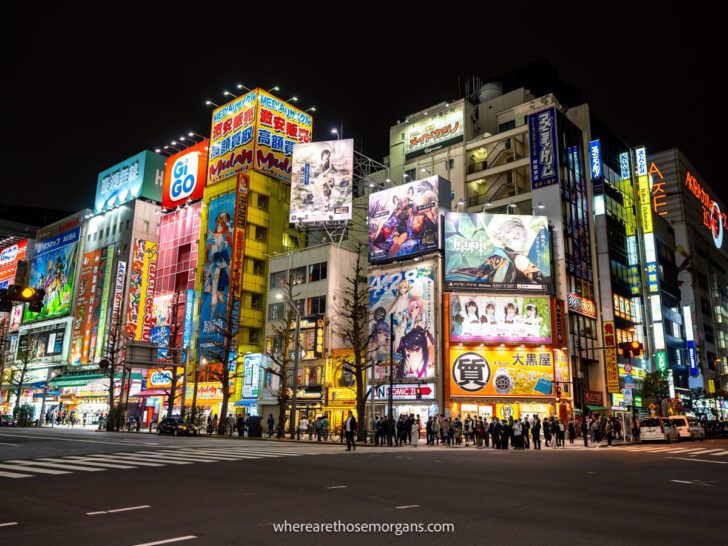Yōkoso Japan! Imagine ancient worlds colliding with technologically advanced and futuristic cities; this is what you’ll get when you visit the amazing country of Japan. It’s easy to visit, it has excellent transport links and it has four extreme seasons for tourists to enjoy.
As travel bloggers, we’re always asked about our all-time favorite travel destinations. And for us, Japan is one of the best places in the world to visit. We love the food, the people, the history and culture, the endless things to do and the sheer uniqueness of the country. We’ve spent more than 5 weeks exploring Japan, and we think it’s one of a kind.
- Capital City: Tokyo
- Population: About 125 million
- Language: Japanese
- Currency: Yen
- Time Zone: Japan Standard Time (UTC+9)
Top Places To Visit In Japan
Tokyo – This enormous and vibrant city is just so much fun to visit. You can walk around stunning gardens, eat at endless hole in the wall restaurants, visit temples and shrines, enjoy a buzzing nightlife and stand on top of towering skyscrapers. It’s a city you simply can’t miss if you visit the Far East.
Osaka – The food scene in Osaka is unbelievably amazing, so make sure you arrive hungry. It’s also really easy to get around and tick off the major attractions, so you only need a few days. We like that it’s less touristy than Tokyo and Kyoto, so it feels a bit more authentic.
Kyoto – For us, Kyoto is the unmissable place to visit in Japan. Maybe it’s because we’re getting a bit older, but if you’re heading to Japan to see temples and shrines, you need to prioritize Kyoto. It’s got a peaceful vibe, a great food scene and so many historical sites to visit.
Nara – During your visit to Osaka or Kyoto, we highly recommend you plan a day trip to Nara. It’s a lovely small town with lots of temples and shrines, plus a huge amount of freely roaming sika deer that you can feed. We stayed at our first onsen ryokan in Nara, which was certainly an experience.
Hiroshima – The Peace Memorial Museum (atom bomb) is a huge draw for Hiroshima. But it also has a great downtown with an abundance of fantastic places to eat, and Miyajima Island which we really enjoyed visiting. It’s a long way west, so make sure you have enough time free.
Hakone – This popular holiday resort on the shores of Lake Ashi has views overlooking Mt Fuji, and it’s just a few hours from Tokyo by bullet train. We spent a few days in one of its traditional hot spring ryokans, and while it was expensive, it was a unique experience.
Kanazawa – Featuring a castle, Edo period architecture and one of Japan’s most celebrated gardens, Kanazawa is one of the best places to visit if you want an authentic experience away from the crowds. Don’t miss the nearby historic UNESCO village of Shirakawa-go.
Takayama – We felt like we’d been transported back to the Edo period when we stayed in Takayama. It’s a small mountain town with attractive wooden buildings, narrow streets and hidden restaurants just waiting to be stumbled across.
Travel Guides
We have lots of free guides on the way for the most popular travel destinations in Japan, but in the meantime here’s what we’ve written so far to get you started:

Nara Day Trip: 4 Things Not To Miss In Japan’s Ancient Capital

Nara Deer Park: How To Avoid Being Bitten By Hungry Sika Deer

Buying Our First Camera In Tokyo, Japan
Most Popular Tours In Japan
How Many Days Do You Need In Japan?
If you’re just visiting Tokyo, you should plan for 3-4 days on a first visit. But we encourage you to look beyond Tokyo to include both Kyoto and Osaka on your itinerary. You can see all three places in as little as one week.
For longer trips to Japan, we recommend you look into Kanazawa, Takayama, Shirakawa-go and the Japanese Alps. This will get you off the beaten path. Alternatively, you could include side trips to Hakone and Hiroshima (or even Okinawa) in addition to Tokyo, Kyoto and Osaka.
If you want to see all of the top tourist spots in one trip, you should plan for 2-3 weeks, depending on how quickly you want to travel.
Best Time To Visit
Japan is unique in that it has four extreme seasons and each could be considered as a peak season in certain parts of the country. Spring brings the famous cherry blossoms, summer is naturally a busier period for travel, fall has stunning foliage and winter brings highly sought after skiing destinations.
We’ve been to Japan in April for cherry blossoms and in October for the fall colors. In truth, we preferred fall. The cherry blossoms were stunning in spring, but it was so busy everywhere and hotel prices were heavily inflated. Fall was quieter, more affordable and honestly more photogenic (we went to the Japanese Alps in the fall and it was like New England in the US).
Next time we visit Japan, we’ll choose between the months of May, June and September because they’ll offer the best balance of costs, crowds, weather and activities.
Note: This page contains affiliate links. When you make a purchase using one of these affiliate links, we may earn a small commission at no extra cost to you.

